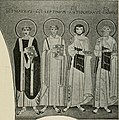File:Monuments of the early church (1901) (14596859130).jpg

Original file (1,672 × 1,688 pixels, file size: 577 KB, MIME type: image/jpeg)
Captions
Captions
Summary[edit]
| DescriptionMonuments of the early church (1901) (14596859130).jpg |
English: Identifier: monumentsofearly00lowr (find matches) |
| Date | |
| Source |
https://www.flickr.com/photos/internetarchivebookimages/14596859130/ |
| Author | Internet Archive Book Images |
| Permission (Reusing this file) |
At the time of upload, the image license was automatically confirmed using the Flickr API. For more information see Flickr API detail. |
| Flickr tags InfoField |
|
| Flickr posted date InfoField | 30 July 2014 |

|
The categories of this image need checking. You can do so here.
|
Licensing[edit]
This image was taken from Flickr's The Commons. The uploading organization may have various reasons for determining that no known copyright restrictions exist, such as: No known copyright restrictionsNo restrictionshttps://www.flickr.com/commons/usage/false
More information can be found at https://flickr.com/commons/usage/. Please add additional copyright tags to this image if more specific information about copyright status can be determined. See Commons:Licensing for more information. |
| This image was originally posted to Flickr by Internet Archive Book Images at https://flickr.com/photos/126377022@N07/14596859130. It was reviewed on 21 September 2015 by FlickreviewR and was confirmed to be licensed under the terms of the No known copyright restrictions. |
21 September 2015
File history
Click on a date/time to view the file as it appeared at that time.
| Date/Time | Thumbnail | Dimensions | User | Comment | |
|---|---|---|---|---|---|
| current | 03:40, 21 September 2015 |  | 1,672 × 1,688 (577 KB) | Fæ (talk | contribs) | == {{int:filedesc}} == {{information |description={{en|1=<br> '''Identifier''': monumentsofearly00lowr ([https://commons.wikimedia.org/w/index.php?title=Special%3ASearch&profile=default&fulltext=Search&search=insource%3A%2Fmonumentsofearly00lowr%2F fin... |
You cannot overwrite this file.
File usage on Commons
There are no pages that use this file.